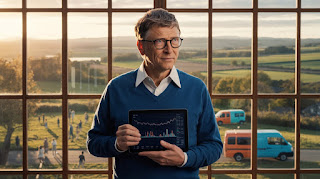Bill Gates’ Shocking Journey: From Teen Programmer to Global Game-Changer
Bill Gates: The Harvard Dropout Who Rewired the World
Introduction: The Birth of a Visionary
In a world driven by conformity, there was one boy who dared to think differently. Born in 1955 in Seattle, Washington, Bill Gates didn’t just dream of success—he engineered it. While others were chasing traditional careers, Gates was busy chasing an idea. An idea that would redefine life, business, and the future itself.
This isn’t just the story of a college dropout.
This is the legacy of the man who transformed personal computing, philanthropy, and the modern world.
Chapter 1: The Boy with the Binary Brain
Early Curiosity: A Genius in the Making
Long before he became a billionaire, young Bill Gates was obsessed with logic, numbers, and computers. While other 13-year-olds were playing sports, Gates was writing his first software program—a simple game of tic-tac-toe, coded on a massive school computer.
By 16, he partnered with his childhood friend Paul Allen to build a traffic counter system for local roads. The pair had a clear mission: solve real-world problems through code.
This early brilliance didn’t go unnoticed. Teachers, parents, and mentors began calling him a prodigy. But Gates never cared for the applause. He wanted autonomy—freedom to think, build, and innovate.
The Harvard Detour: A Temporary Pause
In 1973, Gates enrolled at Harvard University, one of the world’s most prestigious institutions. But academia couldn’t contain his hunger. By 1975, he made a decision that shocked everyone—he dropped out.
Why?
Because he saw something the world didn’t yet understand—the rise of personal computing. While companies were busy building massive mainframes, Gates saw a future where every desk would have a computer. And he didn’t want to wait for someone else to build it.
Chapter 2: Microsoft – A Garage Dream Turned Global Empire
The Birth of Microsoft
That same year, Gates and Paul Allen launched a small startup called Microsoft, a blend of “microcomputer” and “software.” Their goal was crystal clear: put a computer in every home and on every desk.
Their big break came when they developed a version of BASIC for the Altair 8800, one of the first microcomputers. From there, Microsoft’s momentum was unstoppable.
In 1980, they struck a historic deal with IBM to provide an operating system—MS-DOS. What began as a humble contract evolved into a software monopoly, making Microsoft a household name.
By the mid-1990s, Microsoft had launched Windows 95, a user-friendly operating system that revolutionized how we interact with computers. Gates was no longer just a coder—he was a tech titan.
Chapter 3: The Philosophy That Fueled an Empire
Rule #1: Think Ahead
Gates wasn’t building for the present. He was always three steps ahead. While competitors focused on short-term gains, Gates envisioned a long-term digital ecosystem.
He once said:
“If you are born poor, it's not your mistake. But if you die poor, it is.”
This mindset wasn’t about wealth. It was about responsibility—to yourself, your vision, and the world.
Rule #2: Learn Relentlessly
Despite his massive success, Gates never stopped learning. Known to read 50+ books a year, he’s a student of history, science, and innovation. He believes that every answer begins with the right question.
Rule #3: Give Back
In 2000, Gates made another bold move. He stepped down as Microsoft’s CEO and shifted his focus to philanthropy. Alongside his then-wife Melinda, he created the Bill & Melinda Gates Foundation—now the largest private charitable foundation in the world.
Their mission?
To improve healthcare, reduce poverty, and expand educational access globally.
He didn’t just donate money—he applied the same precision and strategy he used at Microsoft to solve human problems.
Chapter 4: From Software King to Global Humanitarian
Redefining Success
For Gates, success was never about yachts or lavish parties. It was about impact. While other billionaires raced to space, Gates raced to eradicate malaria, polio, and HIV in underserved regions.
He invested in vaccines long before global pandemics made headlines. He tackled sanitation, agriculture, and education in developing countries. And through it all, he remained humble, calculated, and obsessed with outcomes.
Facing Controversy with Composure
Gates’s rise wasn’t without criticism. Microsoft faced antitrust lawsuits, and he was called ruthless in business circles. But Gates never backed down. He addressed legal issues, learned from them, and came out stronger.
Even after his personal life made headlines—especially during his divorce—Gates stayed focused on purpose over perception.
Chapter 5: Bill Gates in 2025 – A Living Legacy
Today, Bill Gates has a net worth exceeding $130 billion, but money no longer defines him.
What defines him is:
800 million lives improved through vaccinations
Millions of children given access to clean water and education
Nations inspired to think differently about public health
He once said:
“Success is a lousy teacher. It seduces smart people into thinking they can’t lose.”
That humility, that desire to always improve, is what separates Gates from many of his peers.
Still Learning. Still Building. Still Giving.
Even now, at 69 years old, Gates starts his day with books, curiosity, and strategic vision. Whether it’s investing in clean energy, fighting climate change, or supporting pandemic preparedness—he’s not done yet.
Conclusion: More Than a Dropout
This is not the story of a boy who left Harvard.
This is the story of a visionary, a rebel, a philanthropist, and a strategist who upgraded not just computers—but the way we think, live, and give.
He didn’t just build Microsoft.
He built a model for thinking big, working hard, and giving back.
So, the next time someone tells you that dropping out is a failure,
just remind them of one name:
Bill Gates.











0 Comments